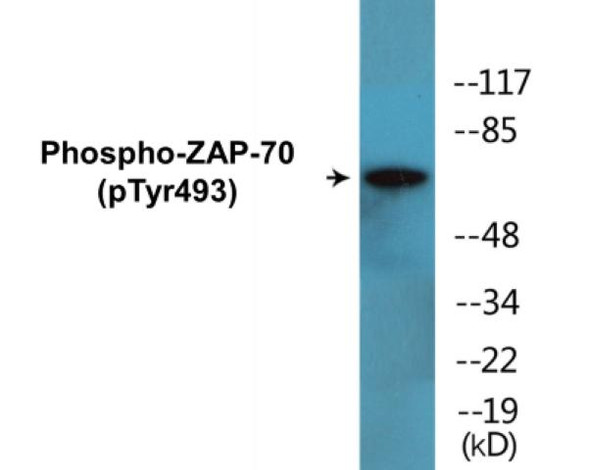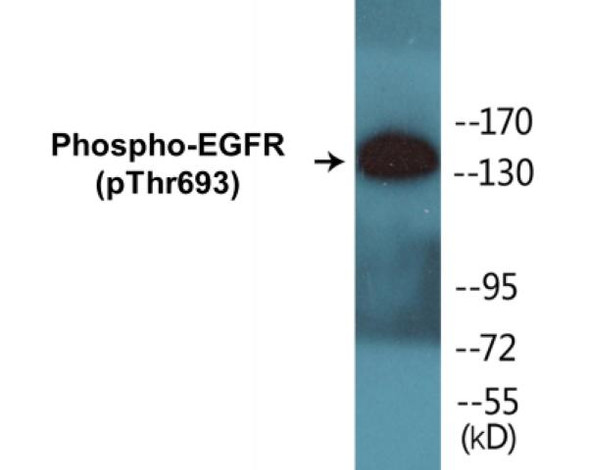Description
ZAP-70 (Phospho-Tyr315) Cell-Based ELISA Kit
The ZAP-70 (Phospho-Tyr315) Cell-Based ELISA Kit is a convenient, lysate- free, high throughput and sensitive assay kit that can monitor ZAP-70 phosphorylation and expression profile in cells. The kit can be used for measuring the relative amounts of phosphorylated ZAP-70 in cultured cells as well as screening for the effects that various treatments, inhibitors (ie. siRNA or chemicals), or activators have on ZAP-70 phosphorylation.
How does our ZAP-70 (Phospho-Tyr315) Fluorometric Cell-Based ELISA Kit work?
Qualitative determination of ZAP-70 (Phospho-Tyr315) concentration is achieved by an indirect ELISA format. In essence, ZAP-70 (Phospho-Tyr315) is captured by ZAP-70 (Phospho-Tyr315)-specific primary (1°) antibodies while Dye 1-conjugated and Dye 2-conjugated secondary (2°) antibodies bind the Fc region of the 1° antibody. Through this binding, the dye conjugated to the 2° antibody can emit light at a certain wavelength given proper excitation, hence allowing for a fluorometric detection method. Due to the qualitative nature of the Cell-Based ELISA, multiple normalization methods are needed:
| 1. | A monoclonal antibody specific for human GAPDH is included to serve as an internal positive control in normalizing the target RFU values. |
| 2. | An antibody against the nonphosphorylated counterpart of ZAP-70 (Phospho-Tyr315) is also provided for normalization purposes. The RFU values obtained for non-phosphorylated ZAP-70 can be used to normalize the RFU value for phosphorylated ZAP-70. |
ZAP-70 (Phospho-Tyr315) Fluorometric Cell-Based ELISA Kit -Information
| Product Name: | ZAP-70 (Phospho-Tyr315) Fluorometric Cell-Based ELISA Kit |
| Product Code/SKU: | FBCAB00037 |
| Description: | The ZAP-70 (Phospho-Tyr315) Fluorometric Cell-Based Phospho ELISA Kit is a convenient, lysate-free, high throughput and sensitive assay kit that can monitor ZAP-70 (Phospho-Tyr315) protein phosphorylation and expression profile in cells. The kit can be used for measuring the relative amounts of phosphorylated ZAP-70 (Phospho-Tyr315) in cultured cells as well as screening for the effects that various treatments, inhibitors (ie. siRNA or chemicals, or activators have on ZAP70 phosphorylation. |
| Dynamic Range: | > 5000 Cells |
| Detection Method: | Fluorometric |
| Storage/Stability: | 4°C/6 Months |
| Reactivity: | Human, Mouse |
| Assay Type: | Cell-Based ELISA |
| Database Links: | Gene ID: 7535, UniProt ID: P43403, OMIM #: 176947, Unigene #: Hs.234569 |
| Format: | Two 96-Well Plates |
| NCBI Gene Symbol: | ZAP70 |
| Sub Type: | Phospho |
| Target Name: | Phospho-ZAP-70 (Tyr315) |
Kit Principle
Figure: Schematic representation of Assay Genie Cell-Based Fluorometric ELISA principle
Kit components | Quantity |
| 96-Well Black Cell CultureClear-Bottom Microplate | 2 plates |
| 10X TBS | 24 ml |
| Quenching Buffer | 24 ml |
| Blocking Buffer | 50 ml |
| 15X Wash Buffer | 50 ml |
| Primary Antibody Diluent | 12 ml |
| 100x Anti-Phospho Target Antibody | 60 µl |
| 100x Anti-Target Antibody | 60 µl |
| Anti-GAPDH Antibody | 110 µl |
| Dye-1 Conjugated Anti-Rabbit IgG Antibody | 6 ml |
| Dye-2 Conjugated Anti-Mouse IgG Antibody | 6 ml |
| Adhesive Plate Seals | 2 seals |
Additional equipment and materials required
The following materials and/or equipment are NOT provided in this kit but are necessary to successfully conduct the experiment:
- Fluorescent plate reader with two channels at Ex/Em: 651/667 and 495/521
- Micropipettes capable of measuring volumes from 1 µl to 1 ml
- Deionized or sterile water (ddH2O)
- 37% formaldehyde (Sigma Cat# F-8775) or formaldehyde from other sources
- Squirt bottle, manifold dispenser, multichannel pipette reservoir or automated microplate washer
- Graph paper or computer software capable of generating or displaying logarithmic functions
- Absorbent papers or vacuum aspirator
- Test tubes or microfuge tubes capable of storing ≥1 ml
- Poly-L-Lysine (Sigma Cat# P4832 for suspension cells)
- Orbital shaker (optional)
Kit Protocol
This is a summarized version of the kit protocol. Please view the technical manual of this kit for information on sample preparation, reagent preparation and plate lay out.
| 1. | Seed 200 µl of desired cell concentration in culture medium into each well of the 96-well plates. For suspension cells and loosely attached cells, coat the plates with 100 µl of 10 µg/ml Poly-L-Lysine (not included) to each well of a 96-well plate for 30 minutes at 37°C prior to adding cells. |
| 2. | Incubate the cells for overnight at 37°C, 5% CO2. |
| 3. | Treat the cells as desired. |
| 4. | Remove the cell culture medium and rinse with 200 µl of 1x TBS, twice. |
| 5. | Fix the cells by incubating with 100 µl of Fixing Solution for 20 minutes at room temperature. The 4% formaldehyde is used for adherent cells and 8% formaldehyde is used for suspension cells and loosely attached cells. |
| 6. | Remove the Fixing Solution and wash the plate 3 times with 200 µl 1x Wash Buffer for 3 minutes. The plate can be stored at 4°C for a week. |
| 7. | Add 100 µl of Quenching Buffer and incubate for 20 minutes at room temperature. |
| 8. | Wash the plate 3 times with 1x Wash Buffer for 3 minutes each time. |
| 9. | Dispense 200 µl of Blocking Buffer and incubate for 1 hour at room temperature. |
| 10. | Wash 3 times with 200 µl of 1x Wash Buffer for 3 minutes each time. |
| 11. | Add 50 µl of Primary Antibody Mixture P to corresponding wells for ZAP-70 (Phospho-Tyr315) detection. Add 50 µl of Primary Antibody Mixture NP to the corresponding wells for total ZAP-70 detection. Cover the plate with parafilm and incubate for 16 hours (overnight) at 4°C. If the target expression is known to be high, incubate for 2 hours at room temperature. |
| 12. | Wash 3 times with 200 µl of 1x Wash Buffer for 3 minutes each time. |
| 13. | Add 50 ul of Secondary Antibody Mixture to corresponding wells and incubate for 1.5 hours at room temperature in the dark. |
| 14. | Wash 3 times with 200 µl of 1x Wash Buffer for 3 minutes each time. |
| 15. | Read the plate(s) at Ex/Em: 651/667 (Dye 1) and 495/521 (Dye 2). Shield plates from direct light exposure. |
| 16. | Wash 3 times with 200 µl of 1x Wash Buffer for 5 minutes each time. |
ZAP-70 (Phospho-Tyr315) - Protein Information
| UniProt Protein Function: | ZAP70: a tyrosine kinase of the Syk family. Associates with the T-cell antigen receptor zeta-chain after TCR stimulation. Phosphorylated by Src-family kinases following antigen receptor activation. Plays a role in lymphocyte activation. |
| UniProt Protein Details: | Protein type:Kinase, protein; Protein kinase, TK; EC 2.7.10.2; Protein kinase, tyrosine (non-receptor); TK group; Syk family Chromosomal Location of Human Ortholog: 2q12 Cellular Component: cytoplasm; cytosol; extrinsic to internal side of plasma membrane; immunological synapse; intercellular junction; lipid raft; plasma membrane; T cell receptor complex Molecular Function:ATP binding; non-membrane spanning protein tyrosine kinase activity; phosphotyrosine binding; protein binding; protein-tyrosine kinase activity; receptor binding Biological Process: adaptive immune response; B cell activation; B cell receptor signaling pathway; beta selection; immune response; innate immune response; macrophage activation during immune response; negative thymic T cell selection; neutrophil activation during immune response; peptidyl-tyrosine phosphorylation; positive regulation of alpha-beta T cell differentiation; positive regulation of alpha-beta T cell proliferation; positive regulation of B cell differentiation; positive regulation of calcium-mediated signaling; positive regulation of cell adhesion mediated by integrin; positive regulation of mast cell degranulation; positive regulation of T cell differentiation; positive thymic T cell selection; protein amino acid phosphorylation; T cell activation; T cell differentiation; T cell receptor signaling pathway; transmembrane receptor protein tyrosine kinase signaling pathway Disease: Selective T-cell Defect |
| NCBI Summary: | This gene encodes an enzyme belonging to the protein tyrosine kinase family, and it plays a role in T-cell development and lymphocyte activation. This enzyme, which is phosphorylated on tyrosine residues upon T-cell antigen receptor (TCR) stimulation, functions in the initial step of TCR-mediated signal transduction in combination with the Src family kinases, Lck and Fyn. This enzyme is also essential for thymocyte development. Mutations in this gene cause selective T-cell defect, a severe combined immunodeficiency disease characterized by a selective absence of CD8-positive T-cells. Two transcript variants that encode different isoforms have been found for this gene. [provided by RefSeq, Jul 2008] |
| UniProt Code: | P43403 |
| NCBI GenInfo Identifier: | 1177044 |
| NCBI Gene ID: | 7535 |
| NCBI Accession: | P43403.1 |
| UniProt Secondary Accession: | P43403,Q6PIA4, Q8IXD6, Q9UBS6, A6NFP4, |
| UniProt Related Accession: | P43403 |
| Molecular Weight: | 55,873 Da |
| NCBI Full Name: | Tyrosine-protein kinase ZAP-70 |
| NCBI Synonym Full Names: | zeta chain of T cell receptor associated protein kinase 70kDa |
| NCBI Official Symbol: | ZAP70 |
| NCBI Official Synonym Symbols: | SRK; STD; TZK; STCD; ZAP-70 |
| NCBI Protein Information: | tyrosine-protein kinase ZAP-70 |
| UniProt Protein Name: | Tyrosine-protein kinase ZAP-70 |
| UniProt Synonym Protein Names: | 70 kDa zeta-chain associated protein; Syk-related tyrosine kinase |
| Protein Family: | Tyrosine-protein kinase |
| UniProt Gene Name: | ZAP70 |
| UniProt Entry Name: | ZAP70_HUMAN |







